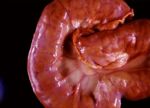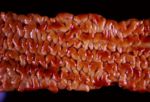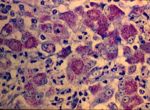| Also known as: | Paratuberculosis |
Johne's Disease is caused by Mycobacterium avium subsp. paratuberculosis. This chronic mycobacterial infection primarily affects the small intestine, and is most commonly seen in cattle, sheep and goats.
Johne's disease refers to the condition caused by the mycrobacterial infection. Calves are most commonly affected by this condition, and can be infected via a number of routes. They may be infected by ingestion of infected manure, or via transmammary infection. In addition, calves may also be infected in vitro, or may ingest the bacteria via colostrum.
There are three stages of infection in Johne's disease.
Stage 1: This often goes unnoticed, as it is subclinical. It typically affects animals less than two years of age, and will advance to stage II, only a few months later.
Stage 2: This is again a subclinical infection, usually affecting older heifers, or young adults. Infected animals are apparently healthy, but are shedding infection within their manure, infecting the environment.
Stage 3: Advanced infection. Animals will show clear clinical signs, including weight loss, decreased milk production, and a severe reduction in appetite.
Animals with advanced stage 3 will appear gaunt, and the meat is no longer deemed fit for human consumption. Once the disease is present in the herd, it is ver difficult to get rid of it.
Clinical
- Clinical signs develop in older cows after calving i.e. 3 to 4 years of age.
- BUT animals are infected as calves less than 6 months old
- The disease develops very slowly.
- Clinical signs include:
- Ongoing, chronic profuse diarrhoea.
- Paint like consistency.
- Hindquarters and tail-caked with faeces
- Faeces also splattered on walls.
- Animal gradually fades away and dies over the course of months.
- Ongoing, chronic profuse diarrhoea.
Pathogenesis
- Organisms get in through the M-cells of Peyer's patches.
- Mycobacteria invade macrophages and cause a granulomatous inflammatory response.
- Death results from:
- Damage to the mucosa.
- Nutrients cannot be absorbed.
- Inflammatory loss of protein
- I.e. a protein losing enteropathy (hypoalbuminaemia).
- Damage to the mucosa.
Pathology
Gross
- Quite typical
- Cows appear very emaciated.
- Depends on how long the disease has been there.
- Not very much to see!
- Fat is pale and oedematous, and there is not much of it.
- Signs are confined to the terminal small intestine (especially the ileum) but are characteristic.
- Diffusely thickened mucosa
- Transverse, corrugated ruggae with reddened crests.
- Cannot extend the gut to remove these (i.e. they are permanent ruggae).
- Velvety mucosal surface.
- Mucosa may take on a 'corn-on-the-cob' appearance in advanced cases.
- Transverse, corrugated ruggae with reddened crests.
- Serosal oedema.
- Distended lymphatics.
- Diffusely thickened mucosa
- Enlarged mesenteric lymph nodes.
- Changes are milder in sheep and goats.
- Often missed.
- May produce small areas of necrosis not usually seen in cattle.
- Sheep may get a pigmented form.
Histologically
- Many large macrophages (epithelioid macrophages) in mucosa, submucosa and lymph nodes.
- Mesenteric lymph nodes are pale and enlarged (though not necrotic).
- The lamina propria is infiltrated by sheets of macrophages with some lymphocytes.
- Acid-fast bacteria are found in the macrophages and giant cells.
- Detected by Ziehl-Neelson stain.
- Bacteria act like foreign body producing a type IV hypersensitivity reaction.
- Sheep have two different forms.
- Paucibacillary
- Many T cells
- Few bacilli
- Multibacillary
- Many macrophages
- Many bacilli in macrophages
- Few lymphocytes
- Paucibacillary


